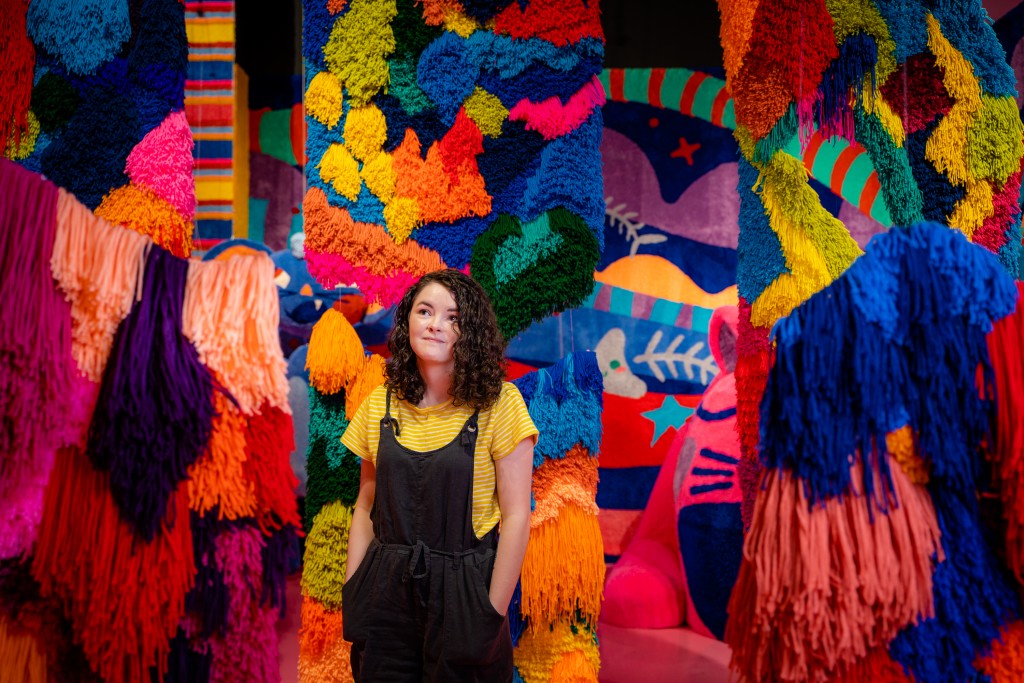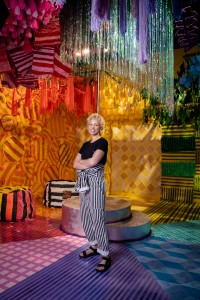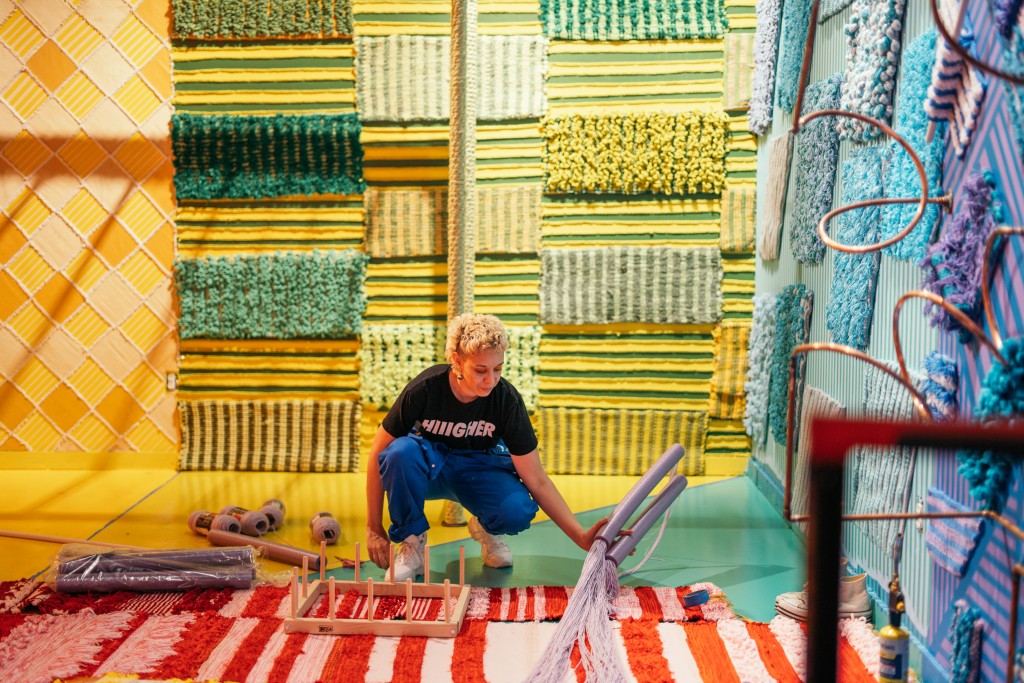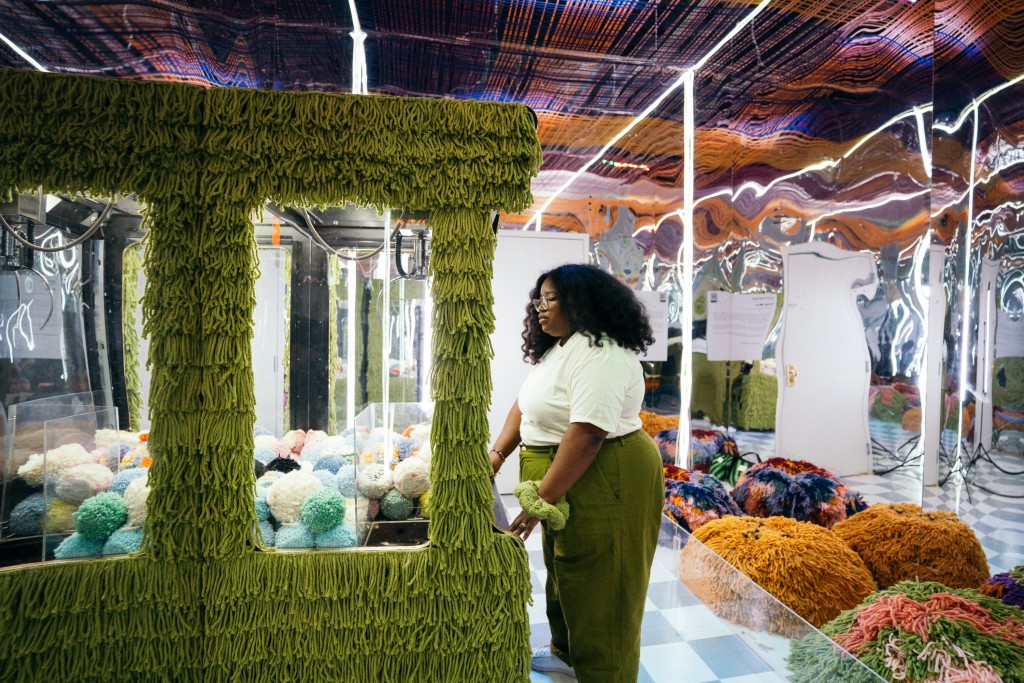From Sex to Self-Care, Fiber Art Is Full Of Possibility
ArtandSeek.net July 16, 2020 83More than 2.5 million feet of yarn fill seemingly every inch of Sweet Tooth Hotel.
“It’s almost 9,000 football fields,” said the art space’s founder, Jencey Keeton.
Sweet Tooth’s latest exhibition, “Intangible,” is more than year in the making. It features crocheted pastries, fuzzy pom poms, even a big cat made of hot pink carpet. The venue, along with the Craft Yarn Council, gave mountains of yarn to a group of artists.
The result is delightfully bright and playful, but filling the 5,000 square foot venue was also painstaking work.

Lawrence said her work can be physically demanding, but she likens it to a spiritual experience. Photo courtesy of Sweet Tooth Hotel.
“You have to work with one little strand of yarn at a time, so it really is something you have to chip away at little by little,” said Jackie Lawrence, one of the exhibition’s featured fiber artists.
She’s constructed massive panels — 10 feet high and 20 feet wide — that hang from the ceiling like shaggy, multi-colored waterfalls.
She used a latch hooking technique. It’s a process she learned in the now-defunct fiber arts program at the University of North Texas.
So, what exactly is fiber?
“It’s a 3D line that you can draw in space with,” she said.
You can also think of it as any material that can be spun into thread like cotton or wool.
From there, you can knit it, crochet it, embroider it. The possibilities are endless.
While it may sound like your grandma’s favorite hobby, fiber artists have been working for decades to stake their claim in the fine art world.
“We’ve always had to straddle the line between craft and fine art,” Lawrence said.

Jackie Lawrence used a latch hooking technique to construct massive, multi-colored yarn panels. Photo courtesy of Sweet Tooth Hotel.
All of the artists featured in “Intangible” are women, and women have been at the forefront of the medium.
Artists like Judy Chicago have long used textiles and techniques like needlework to subvert the history of what’s historically been considered “women’s work.” What separates fiber art from simply craft is the deep meaning each artist weaves into this meticulous, physically demanding work.
“For me, it’s this process of manifesting that inside world that I often hide from people and getting to put it out here and feeling like I’m building up my world one piece of yarn at a time,” Lawrence said.
Molding vibrant, fibrous landscapes with her hands is a spiritual experience for her.
For Molly Margaret Sydnor, it’s a political one.

Molly Margaret Sydnor is a multidisciplinary artist who used her installation, “Temporal Jungle,” to explore the duality of childhood and adulthood. Photo courtesy of Sweet Tooth Hotel.
“I am trying to, in your face, say I am here,” Sydnor said. “I am a woman of color. I am queer. This is me.”
Her installation juxtaposes childhood ephemera — monkey bars and fun hoops — with more mature pastimes.
A stripper pole stands at the center. As a child, it was taboo and sexualized, but Sydnor said it doesn’t need to be.
“When you get older you’re able to unlearn things and unlearn truths you were told as a child and become an adult in yourself,” she said.

Molly Margaret Sydnor’s installation is one of 11 yard-crafted worlds inside Sweet Tooth Hotel’s latest exhibition. Photo courtesy of Sweet Tooth Hotel.
Sydnor’s been busy helping people unlearn other things. Her activist squares — colorful, digital illustrations she shares on social media — tackle systemic racism, police brutality and intersectional politics.
“Even though my work feels very fun and childlike, there’s always these underlying, I mean apparently political messaging, but again that’s me,” she said. “That’s my life. My experience.”
Sydnor said she began to lean further into her identity while attending the Maryland Institute College of Art in 2015.
“When Freddie Gray was unjustly murdered,” she said. “That was a time of revelation for me … Ever since my time in Baltimore, I’ve been educating myself and leaning into my identity. It’s not political for me. It’s my life. It could be my dad, my brother, my friend.”
The recent wave of protests that have followed the killing of George Floyd have also fueled Sydnor.
“COVID has me quarantined and scared to do much else, so I haven’t been protesting,” she said.
Her heart condition keeps her from marching, so she channels all that energy into her work.
“I don’t know any other way than to make art,” Sydnor said. “I don’t have the words. I don’t have the experience. All I have is art.”
The protests have touched Niki Dionne in different ways.
“In the midst of it, it was hard,” she said. “But, now that the conversation is still happening and not just fading to the back, it’s inspiring. I’m doing this because I’m trying to put Black joy in the forefront of my brain and not everything that is wrong. I see it as an act of revolution.”

It can take Niki Dionne up to 10 hours to construct one of her giant pom poms. Photo courtesy of Sweet Tooth Hotel.
Sitting at her loom, Dionne cuts, warps and stretches yarn for hours upon hours. It’s an act of self-care.
“When I’m struggling with my thoughts or when anxiety is holding me back, I lose myself in the process,” she said.
Her installation, called “Rigged,” is strewn with giant pom poms. They’re scattered on the floor, along the mirrored walls and in an actual claw machine wrapped in lime green yarn. It’s not until you see another giant macrame claw overhead that it hits you. You’re the one inside a life-sized claw machine.
“I wanted to play with the emotions of that hope that maybe I can win it and the apprehension of I don’t think it’s going to be possible,” Dionne said. “A lot of it I drew from my experience as a Black woman and how it feels like things are rigged against us.”
Black women are a major source of inspiration for Dionne. They adorn her poms, and they’re the main subjects in her delicate, bright pastel portraits.
“Growing up, my skin color was something that I wanted to get away from,” she said. “As I’ve gotten older, it’s something that I’ve learned to embrace and find home and family in that community of women.”
These psychedelic, wild worlds are a trip. No acid required. But, what you see is only half the story. The sweat and tears in the fibers are what make the “Intangible” a work of art.
Got a tip? Email Miguel Perez at mperez@kera.org. You can follow him on Twitter @quillindie.
Art&Seek is made possible through the generosity of our members. If you find this reporting valuable, consider making a tax-deductible gift today. Thank you.











